Category Archive for Fashion
Cape Town colorful murals, street art & Woodstock Exchange. Off to Shanghai, Cebu, HK!
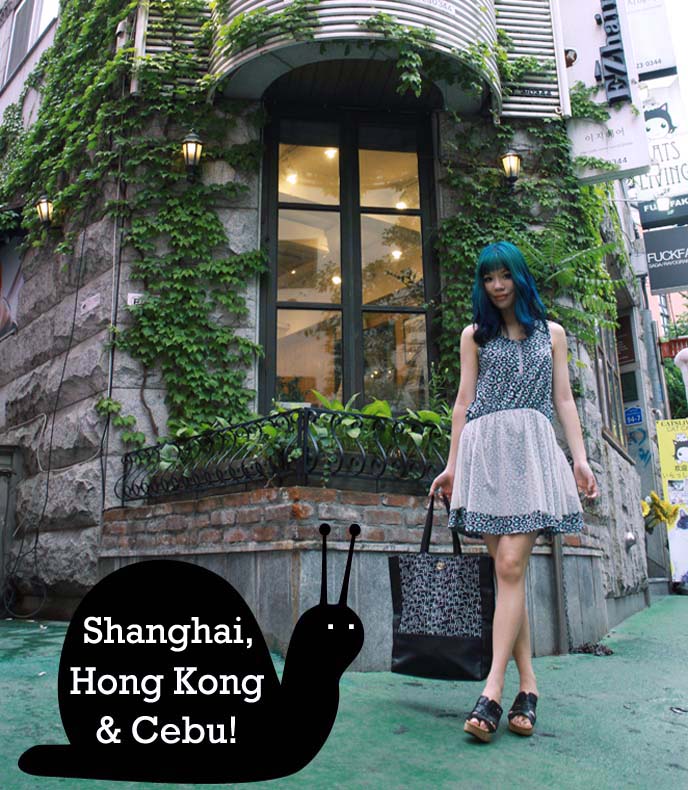
Life has not been crawling at a snail’s pace lately: I’ve been overwhelmed with dream jobs and trips this year. Bear with me, as I put together coverage from my trips to Africa and Asia. In this post, I’ll give you a tour of Cape Town’s colorful art in the Woodstock district.
But first, announcing my next destinations. I’m going back to Hong Kong, and for the first time, I’ll be in Cebu and Shanghai! I’m working on a number of travel projects, including a partnership with a new hotel group. I’m also doing a major network TV shoot in Hong Kong, appearing on-camera as host and also arranging the production.
Finally, whenever my filmmakers and I have a moment to breathe, we’ll capture stories about Asia subcultures for you. If you have tips for places to visit, especially in Shanghai and Cebu, please leave me a comment. (Above, I’m in front of the Cat’s Living cat cafe in Hongdae, Seoul.)

Now, let’s flash-back to my first time in Africa. Archbishop Desmond Tutu described post-apartheid South Africa as a “Rainbow Nation.” His words describe Cape Town’s Woodstock district particularly well. This neighborhood has developed from an inner-city slum into a colorful art haven. Locals live next to design studios, and in homes decorated by international artists.

Juma Mkwela took my team and me on a Woodstock art walking tour. He came to South Africa from Zimbabwe, and was a victim of the 2008 xenophobic attacks. Juma turned this tragedy into an impetus for change: he now uses art to educate children, and inspire social development in disadvantaged areas.

Not long ago, Woodstock was run-down with crime and drugs. In 2011, a local artist called Freddy Sam launched a revival project, aiming to bring pride and color back into the community. Today, Woodstock is a trendy hub with homes painted by dozens of international artists, mainly with messages of peace and love.

Using giant walls and buildings as canvases, these artists — coming from countries like Canada, UK, and China — created art in a mix of creative styles. We spotted what looks like an evil Bart Simpson. (Photography by Melissa Rundle, Eric Bergemann and La Carmina.)

Many paid tribute to Africa, by depicting animals such as the ones we saw at Aquila Safari. An elephant eye stares out from this wall.

Pets are a popular motif. This dog painting integrates with the existing materials of exposed brick and cracked walls.
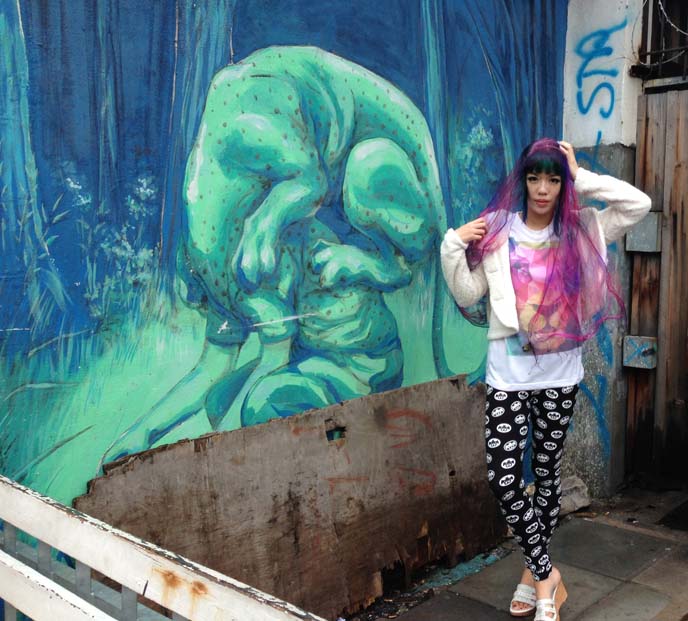
Some of the works are provocative. Argentinian artist JAZ made this “Not Eating” urban mural, showing a big cat devouring a man’s head.

Here’s another version by JAZ, with colors that match the rust of the pole in front. Juma told us that these murals revitalized the area, and created a sense of pride in the community.
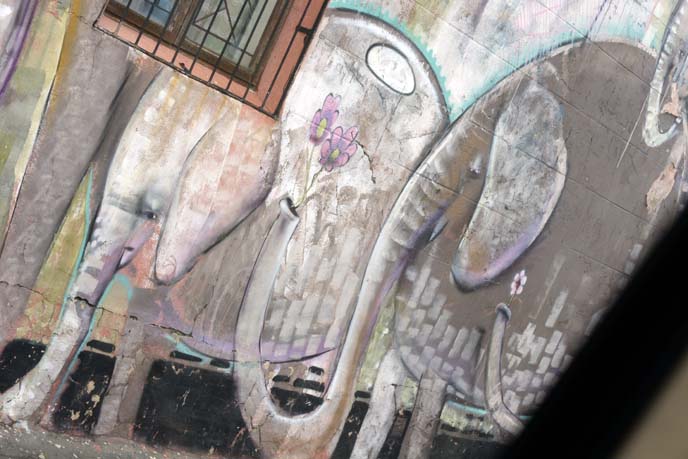
The artists get permission to paint the walls, and work with residents to create a design. Many incorporate portraits of the homeowners, or elements that reflect their personalities. I suppose I’d live in this Victorian home with cute pastel elephants on the front.

Apartheid only ended in 1994, and locals still remember how it loomed over their lives. In the spirit of Nelson Mandela, many chose to paint messages of tolerance. One of my favorites is this “One Heart, One Love” mural by Boamistura, a group of five Madrid artists.
I’m dressed rather internationally: a rainbow lion t-shirt from Chatuchak Market in Bangkok, leggings from Hong Kong’s Izzue, a fuzzy jacket from Peace Now Japan, and a scarf from San Francisco’s Chinatown.

The “most fabulous” award goes to New York’s Cern, who made this purple marvel starring the homeowner’s deceased white cat. I like how he used the curve of the gate to make an elephant’s forehead and trunk.

Juma walked with us all around Woodstock, pointing out hidden works and talking about their inspiration. Colors and cute faces peeked out from alleyways.

Andy Warhol would give a thumb’s up to this wall of product labels.

The Woodstock art initiative has truly uplifted the district. Children help out with the painting, and locals say they’re proud of their decorated homes.

What a coincidence: this segmented rainbow lion statue perfectly matches my Thailand t-shirt! Just by walking around and interacting with the designs, I felt uplifted. I’m a big supporter of using art as a means for positive change.

I could sense that the murals were made with passion. Some had important messages of anti-poaching; this one reminds us that hundreds of rhinos are still killed each year for their horns.

Some works were black and white, and abstract. This intricate design is by Yumanizumu of Japan.

Others encourage you to pose and have fun. Help, I’m being attacked by giant bees!

Quite a few hint at the tumultuous history of Cape Town. Woodstock is next to District 6, where 60,000 people of all ethnicities lived together until they were relocated by force in the 1970s. Today, District Six is razed and empty.
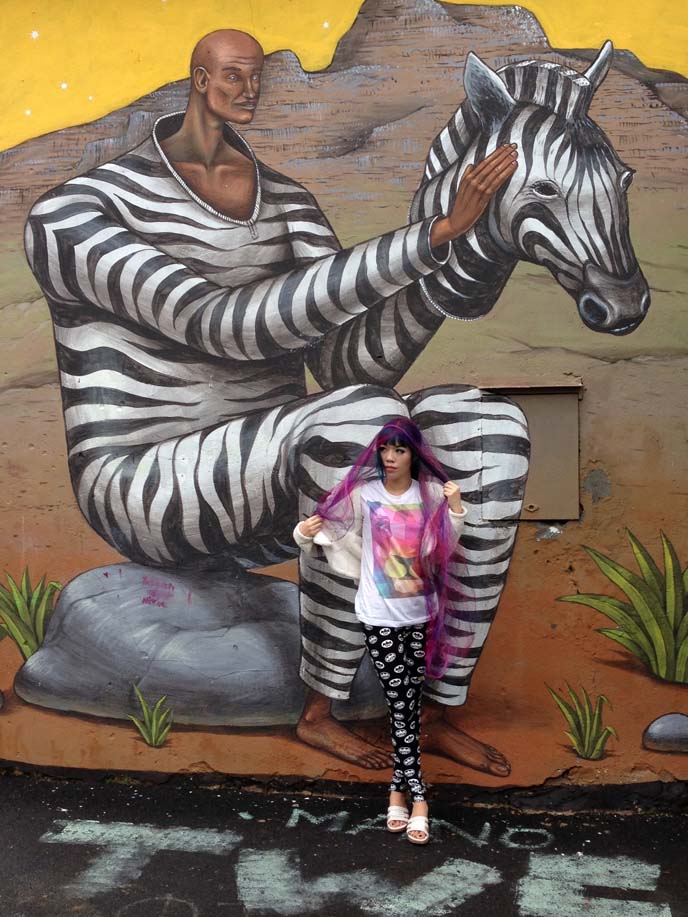
I thought the most successful works were the ones that were vivid, had a connection to Africa, and made you think. Interesni Kazki’s “Zebra Suit” is a great example, and leaves the meaning open to your interpretation.

When Juma told us to look up, we all grinned and did the “Carleton dance.” It’s Will Smith, as the Fresh Prince of Bel Air!

Time to explore Woodstock Exchange or WEX, a modern building that incubates young artists and creative shops. The open space is very Portlandia-hipster, isn’t it?

Woodstock Exchange features public installations, like this swing. I’ll later take you inside the creative studios, where artists work and play.

I’m a fan of this sleeping dog statue by Frank van Reenen. Next door, there are multiple design and fashion boutiques, and art galleries.

We had a healthy lunch at Superette. I could eat their veggie sandwiches and protein-salad plates every day; everything is prepared with locally-source seasonal ingredients. For a drink, it’s hard to decide between the fresh lemonade, ginger kombucha, local roast coffee, and craft beers.
On a different day, we ate fresh seafood at Ocean Jewels in WEX. $4 US for a plate of grilled angelfish and sweet potatoes. Once again, I could have this daily!

Leave room for a drink at Lady Bonin’s Tea Parlour, described as a “Purveyor of Magical Infusions and Tasty Curiosi-Teas.” I tried brewed buchu, a South African woody plant that has traditional medicinal properties, and is drunk to help digestion.

Lady Bonin also serves gluten-free and sugar-free snacks. We tried the matcha, and rooibos with mocha.

Isn’t the street art in Woodstock incredible? Gotta love this blue fellow with Bam Bam hair. Thanks Cape Town Tourism and Juma for the inspiring tour.

I leave you with multicolored works by two Spanish artists. Okuda…

… and Remed. Without doubt, South Africa is a Rainbow Nation.
PS: Don’t forget, I will be in the Philippines (Cebu), China (Shanghai) and Hong Kong soon! Let me know your travel suggestions, and follow along my trips in real-time on my social networks (@lacarmina, linked in the right sidebar).
SHARE & COMMENT
Colorful Cape Town tour! Table Mountain, Bo Kaap houses, Nelson Mandela’s Robben Island.
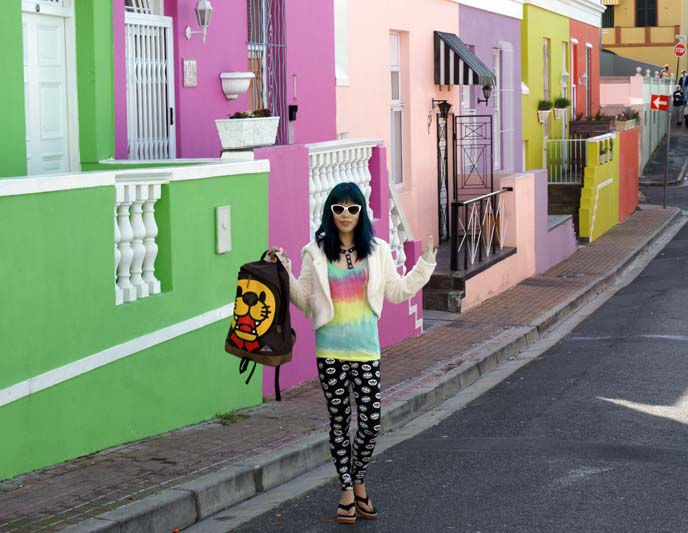
Did you know Cape Town is so colorful? My face says it all: I loved it here. On Day 1, I experienced the city’s kind people, diverse neighborhoods, soulful cooking, and intriguing history.
Follow my rainbow shoes, as I explore the South African city by land, air and water.
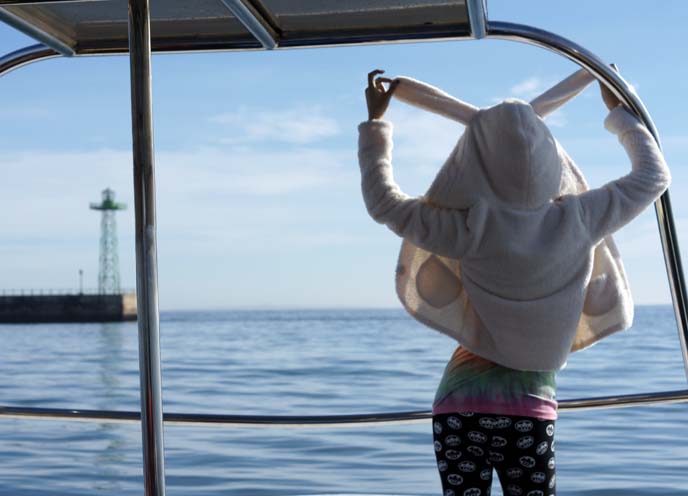
Cape Town’s colorful architecture inspired me to dress accordingly. I’m wearing a Goth/rainbow tie-dyed tank top by Gladnews (the Japanese brand in Shibuya 109). My bunny ears hoodie jacket is by Peace Now. The cute Batman leggings are from Hyoma in Izzue, Hong Kong.

We started the day bright and early, with a private helicopter ride. There’s no better way to see the scenic city and its beaches on the Atlantic Ocean coastline.
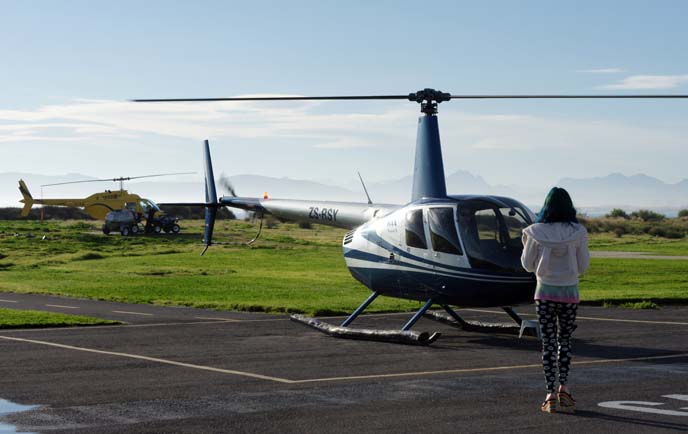
I was here with my two filmmakers, thanks to Cape Town Tourism. Photography in this post by Melissa Rundle and Eric Bergemann. They captured a cinematic shot of helicopters landing with lens flare.
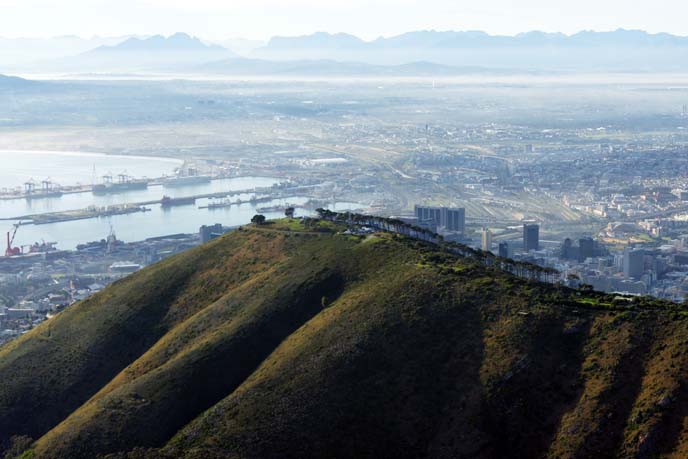
Up in the air — what fun! We felt safe during the helicopter ride, which was smooth and not too noisy. We could even communicate through microphones.
Out the window, we saw this mountain range with a Mohawk of African trees on top.
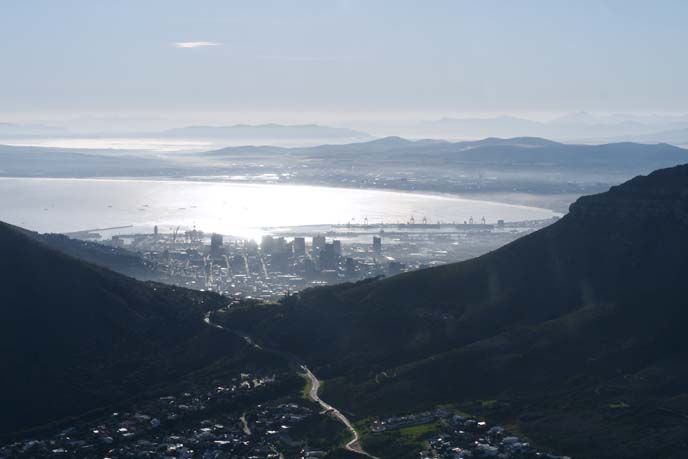
Cape Town began as a Dutch trading settlement, founded in 1652. As you’re probably aware, the city has a tumultuous history from the days of slavery and apartheid, to independence under Nelson Mandela. Today, Cape Town has a new and developed vibe, and is a safe destination for anyone to visit.
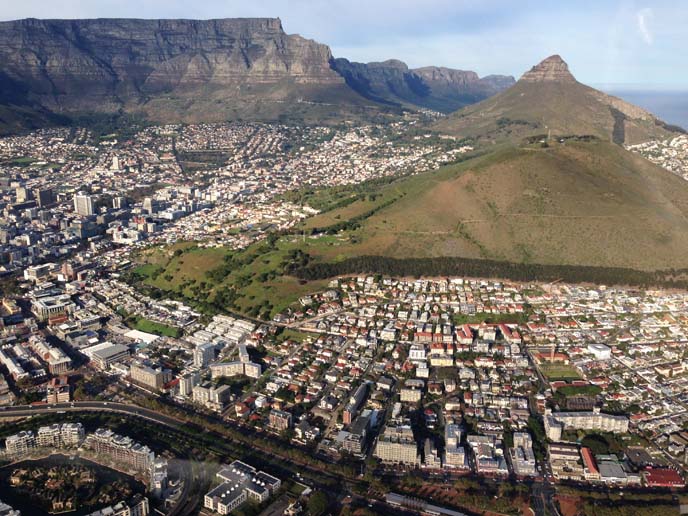
From any point in the city, you can see the famous flat Table Mountain, covered with a “tablecloth” of clouds. Next to it lies the Devil’s Peak, domed Lion’s Head, and Signal Hill.

We flew over Robben Island, in Table Bay. Since the late 17th century, the Dutch have used this as a jail primarily for political prisoners, and as a leper colony. The first post-apartheid President of South Africa, Nelson Mandela, was famously imprisoned on Robben Island for 18 years.
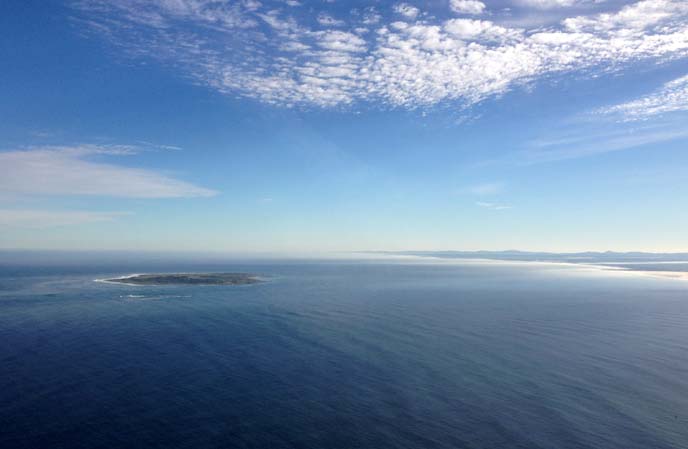
Today, Robben Island is a UNESCO World Heritage Site and museum. Many visitors take the ferry here, and go on tours led by guides who were formerly prisoners on the island.
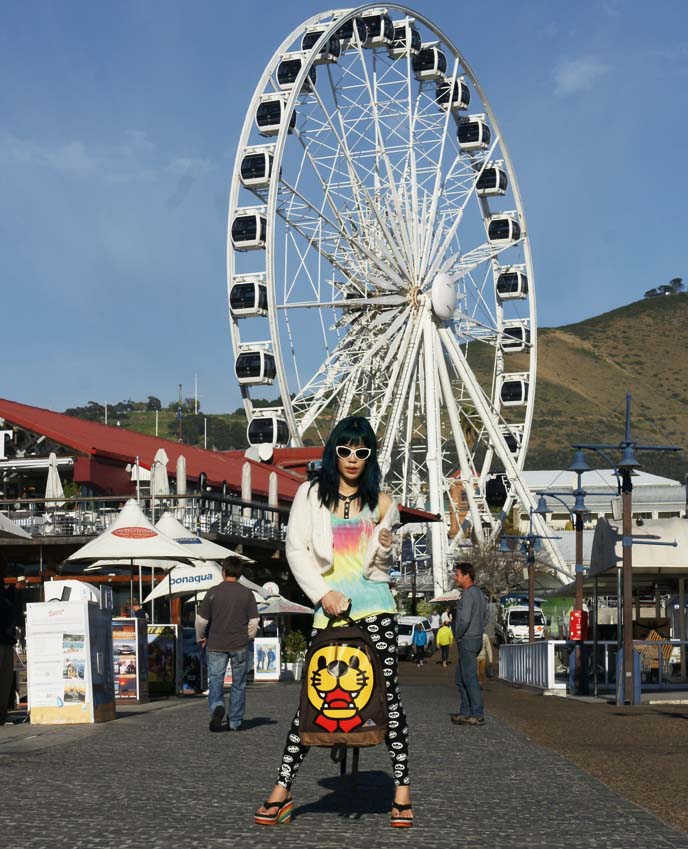
Next, our driver took us to the Victoria & Albert Waterfront, a favorite destination among both locals and tourists. We sampled artisan bread, and browsed African goods in the gift stores. I posed beneath the Ferris wheel with my lion backpack from A Bros Products, Hong Kong.
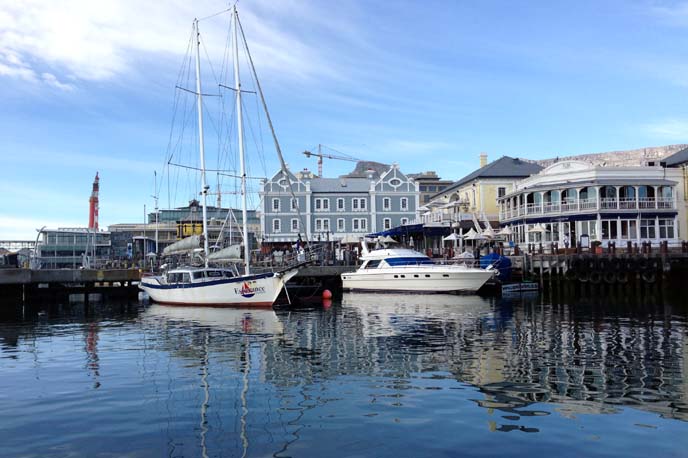
Lots of quaint buildings dot the V & A. There are many attractions for families including the Two Oceans Aquarium, and four museums.
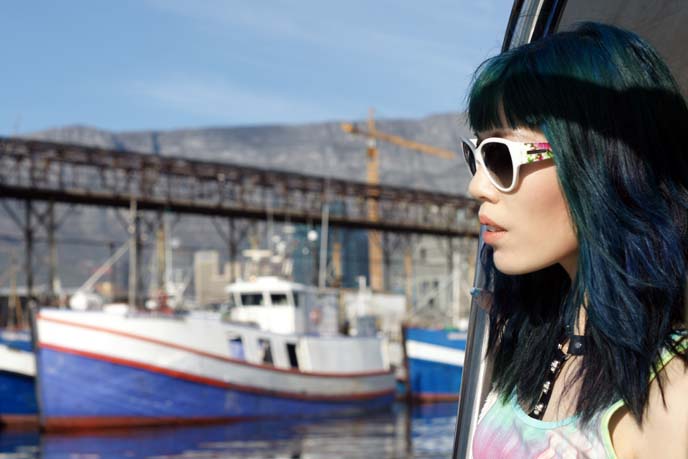
We went on a short boat ride around the harbor. A seal leaped out from the water!
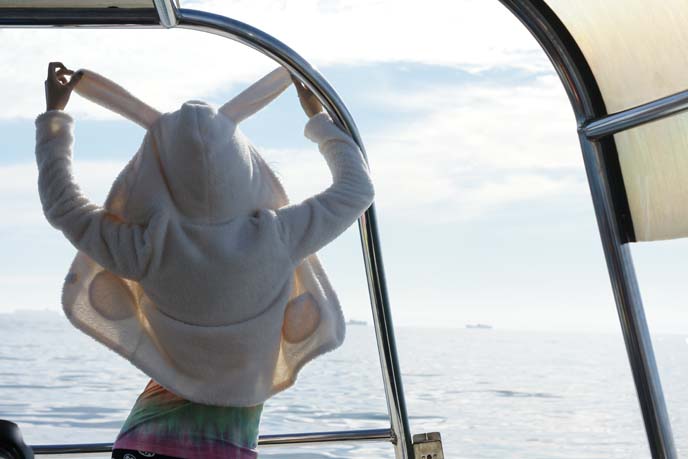
A bunny popped out too. The kids on the boat were rather amused.
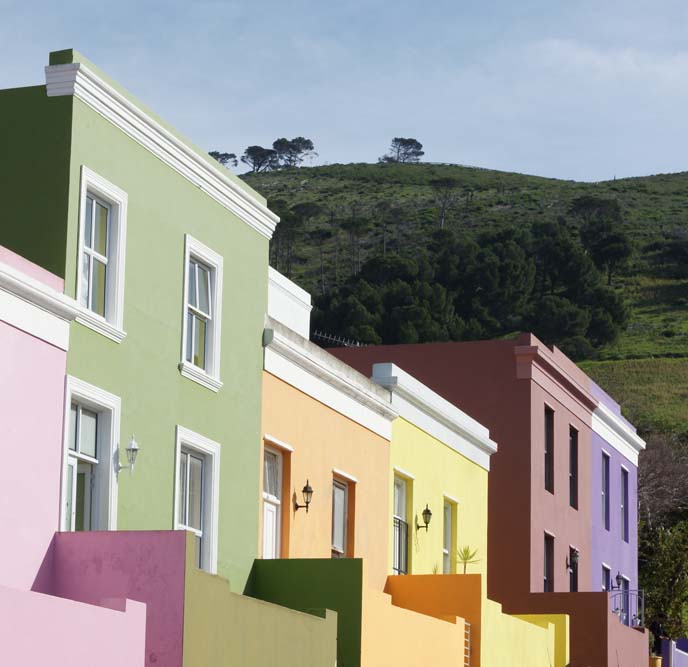
Onward to the Bo-Kaap district, distinguished by this row of rainbow-colored houses. This was the traditional neighborhood for the Cape Malay, an ethnic group descended from the Indian and Malaysian slaves brought over by the Dutch East India Company.

One of the oldest houses is now the Bo Kaap Museum, filled with photos and objects that chronicle the district’s history over the years. Our guide told us about the insane Dutch system of racial classification: Cape Town was divided into black, white, colored, and Indian (each with sub-sections). Many of residents were mixed, and rules were applied indiscriminately.
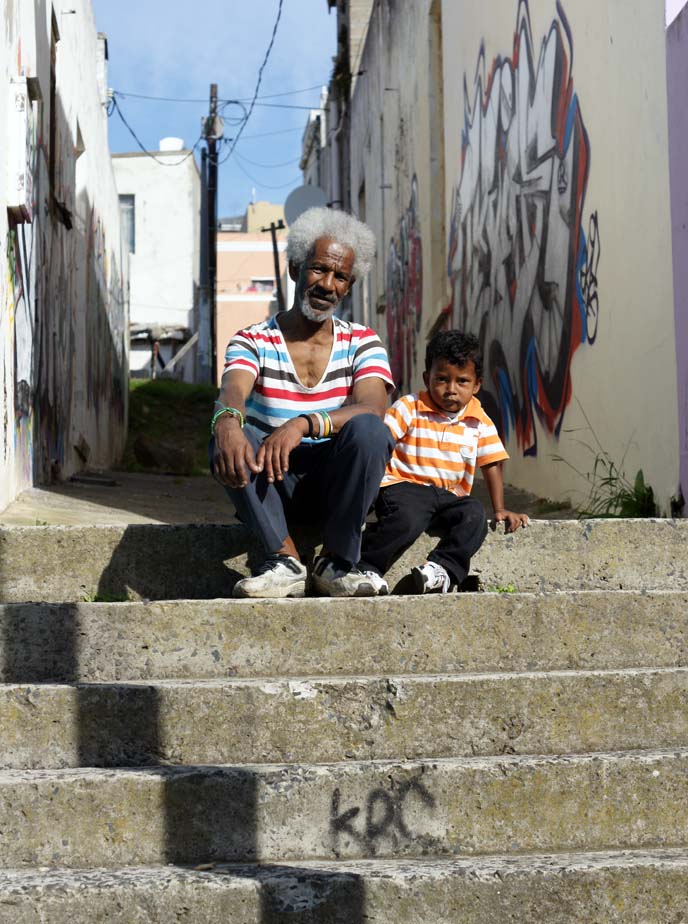
People of “lower” classifications were forced to relocate, often to segregated townships. They received worse treatment in prisons, and limited opportunities for jobs and businesses. I can’t believe that the apartheid system lasted in South Africa until 1994 — only 20 years ago.
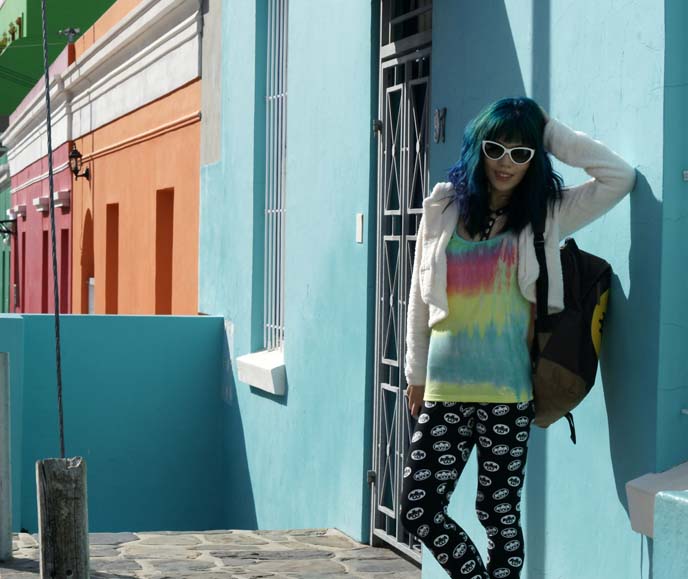
Today, Cape Town feels peaceful, and the city is a mix of cultures. Wale Street, found under Signal Hill, is full of character. In this mostly Muslim community, these houses are painted every year before Eid.
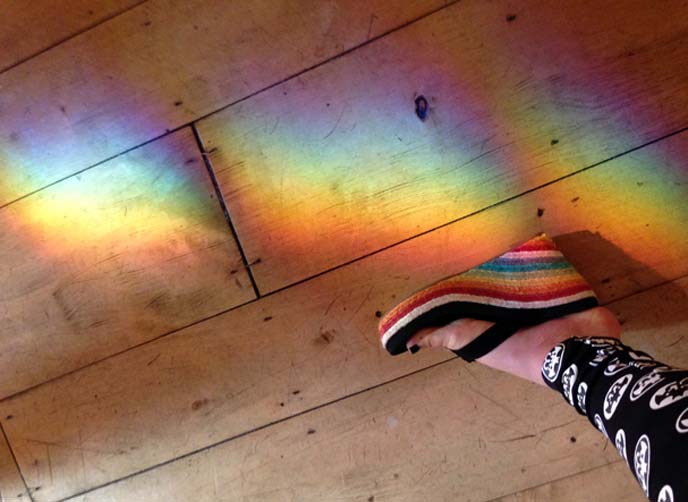
The colors match my sandals with a rainbow platform heel, from Shinjuku Studio Alta. I felt like wearing bright clothing the entire time I was here.
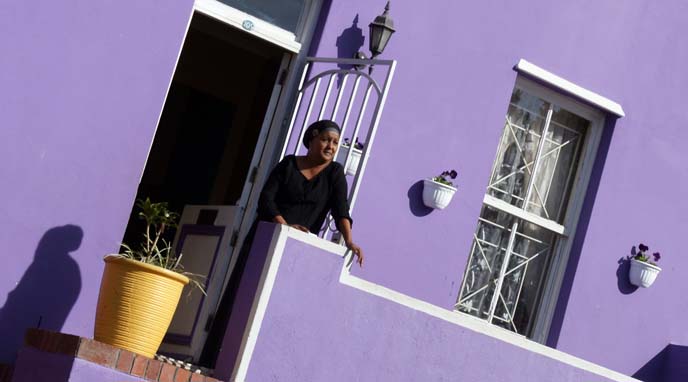
Faldela Tolker lives in the purple house. She offers a unique cooking tour: visitors come into her house to learn how to make Cape Malay specialties, and eat lunch at her table.
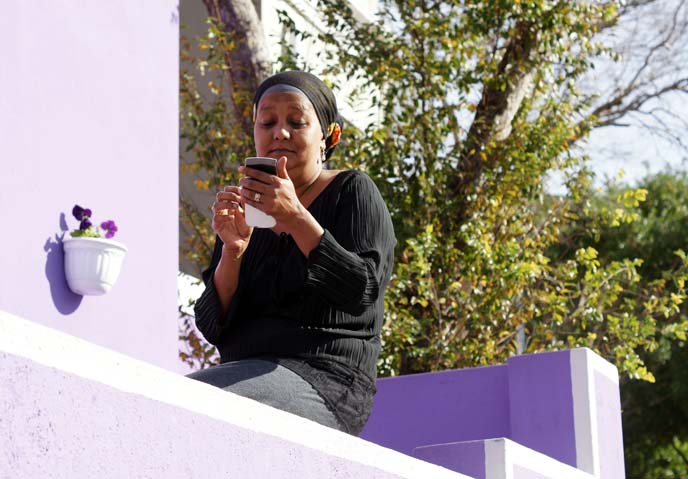
Faldela is one warm, sassy lady! We loved her stories and sayings, like “salt is love.” From the staircase, I glimpsed her grandchild peeking at our table.
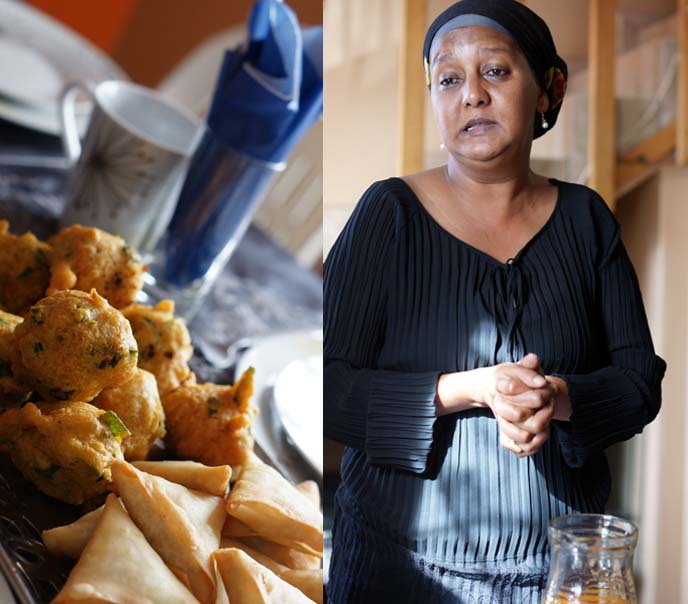
She served us samosas, with spicy sauces on the side. Next came a hearty tomato bredie (a distinctive stew with Indian flavors) and rice. We finished with sweet koesisters, a traditional syrup-coated doughnut, washed down with cardamom tea. It ended up being one of the most memorable meals I had in South Africa, and certainly the warmest.
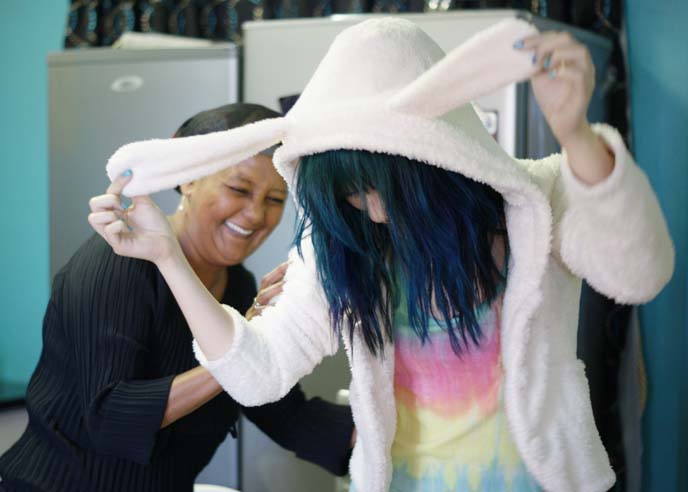
Faldela then showed us how to fold and stuff samosas. She laughed at my bunny hoodie and insisted on trying it on! There’s so much heart in this home, and I’m so grateful I got to join her Cape Malay cooking “safari”.

Across the street lies Atlas Trading, a 70 year old spice shop with bins of exotic flavors. I’m not sure what “ass seeds” are. In the back, we even found cannabis and opium scented incense.
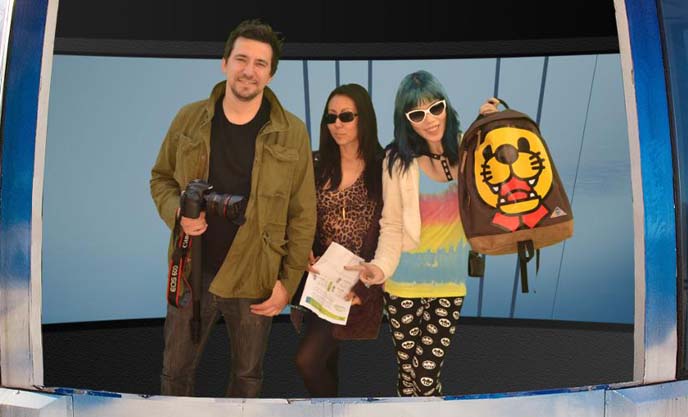
My crew and I ended the afternoon by taking the cable car up Table Mountain. Can you believe we did all of this in a day? Everything is close together in Cape Town, so you never have to travel far to reach attractions.
Before boarding the “aerial cableway,” each group takes a photo in front of a green screen.
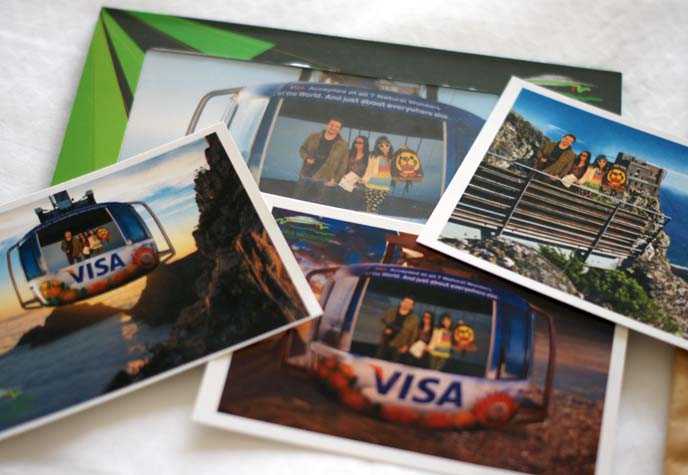
When we left, we saw that this image was superimposed on various backdrops, and packaged as a souvenir! So touristy and cheesy that we had to get them. I can’t stop laughing at how ridiculous we look.
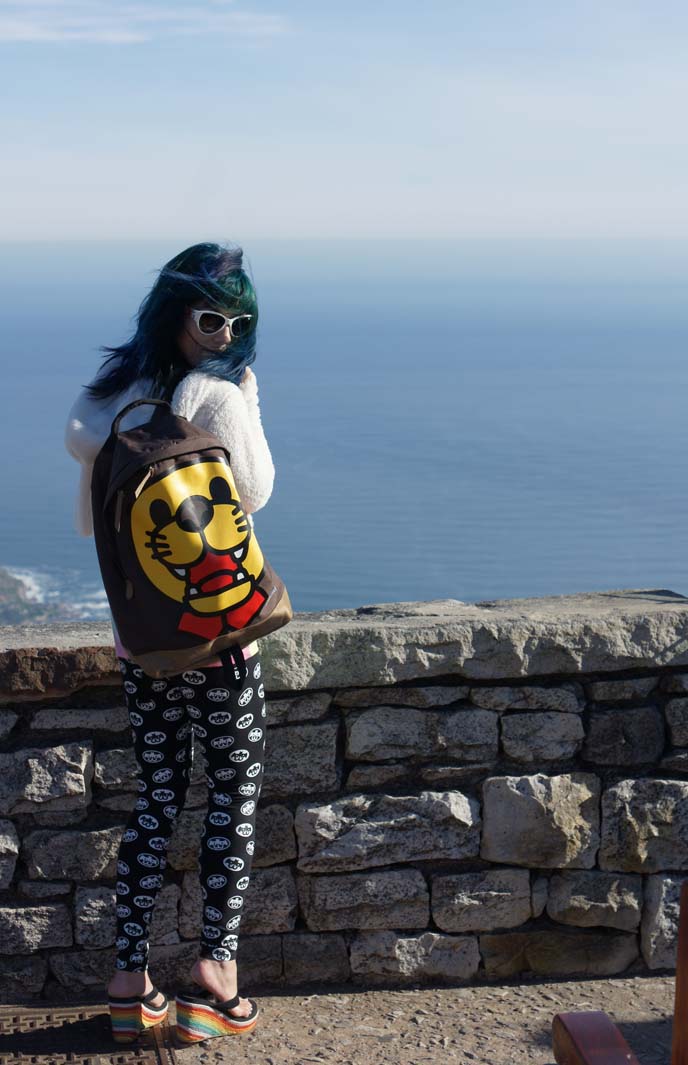
From the top of Table Mountain, we looked down at the rocky coastline and city. I admit we were a bit spoiled by the views we had already seen from the helicopter ride.
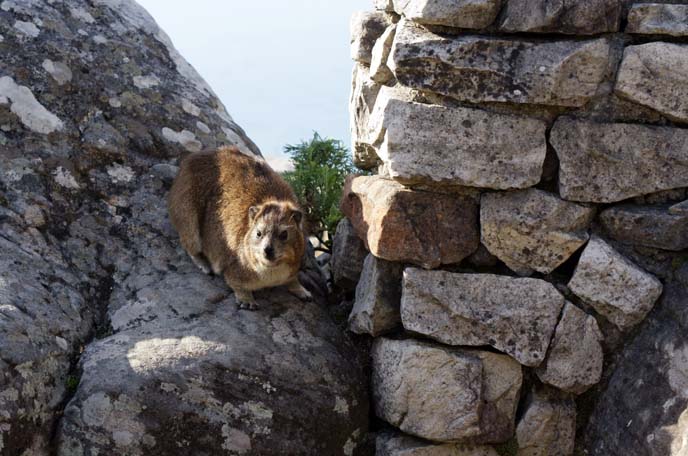
On the way back, we ran into a dassie, a squirrel-like rodent found only in southwestern Africa.
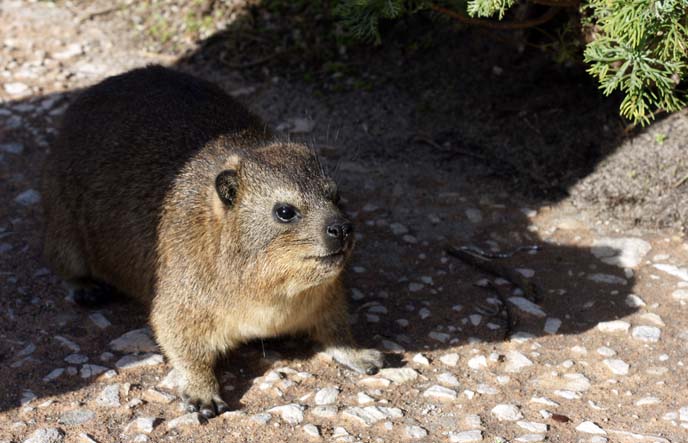
The dassie lives on rocky outcroppings, and since there are tourists carrying food on Table Mountain, they’ve become rather bold.
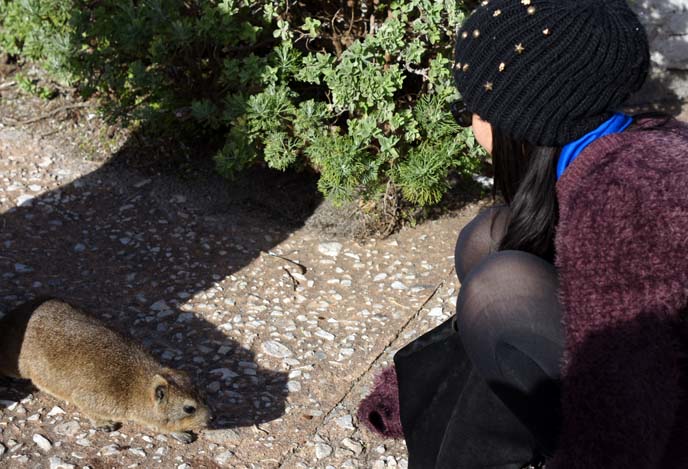
Melissa is doing a big no-no… One shouldn’t touch these wild animals! At least she didn’t get bitten, unlike the peacock that pierced her skin during our safari.

Back to my room at the Taj Hotel. I lay on the bed and stared out at this view of the mountain ranges.

A million thank yous to Cape Town Tourism, for bringing us to this fascinating and beautiful city! Coming up, I’ll take you on a tour of the street art, fashion designers, and African cuisine.
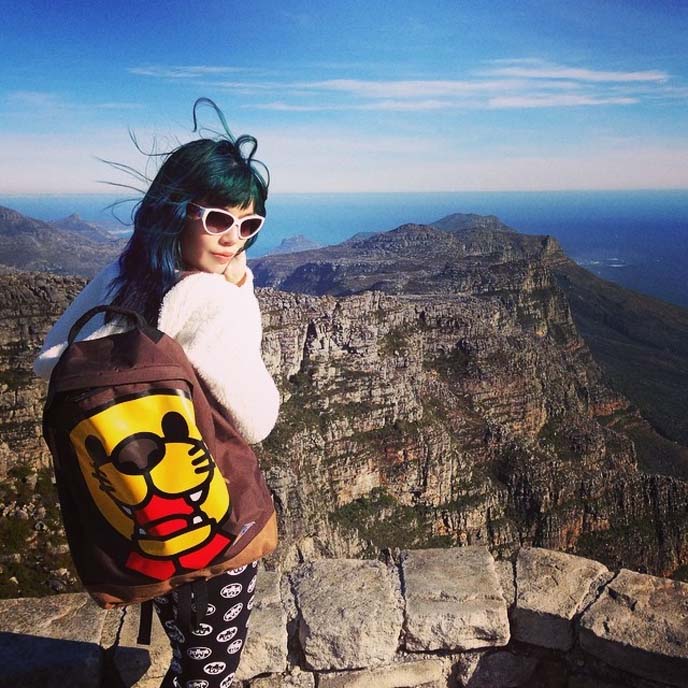
Did you expect South Africa to look like this? Don’t miss out on the bonus photos of my trip, on my @lacarmina Instagram.
 LA CARMINA
LA CARMINA






